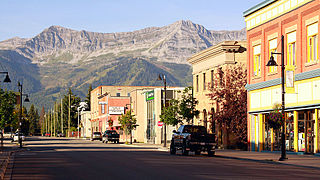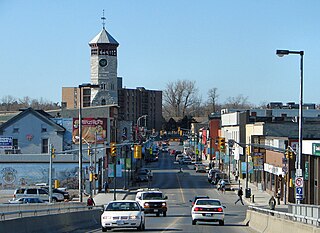Swastika is a symbol with an equilateral cross, with four (or a multiple of four) arms bent at 90 degrees.
Contents
Swastika or Swastik may also refer to:
Swastika is a symbol with an equilateral cross, with four (or a multiple of four) arms bent at 90 degrees.
Swastika or Swastik may also refer to:

The swastika or swastik is an ancient religious and cultural symbol, predominantly found in various Eurasian cultures, as well as some African and American ones. In the West it is more widely recognized as a symbol of the German Nazi Party who appropriated it from Asian cultures starting in the early 20th century. The appropriation continues with its use by neo-Nazis around the world. The swastika never stopped being used as a symbol of divinity and spirituality in Indian religions, including Hinduism, Buddhism, and Jainism. It generally takes the form of a cross, the arms of which are of equal length and perpendicular to the adjacent arms, each bent midway at a right angle.
Stratford may refer to:
Scarborough or Scarboro may refer to:

Belleville is a city in Ontario, Canada situated on the eastern end of Lake Ontario, located at the mouth of the Moira River and on the Bay of Quinte. Belleville is between Ottawa and Toronto, along the Quebec City-Windsor Corridor. Its population as of the 2021 Canadian census was 55,071. It is the seat of Hastings County, but politically independent of it, and is the centre of the Bay of Quinte Region.

Fernie is a city in the Elk Valley area of the East Kootenay region of southeastern British Columbia, Canada, located on BC Highway 3 on the western approaches to the Crowsnest Pass through the Rocky Mountains. Founded in 1898 and incorporated as the City of Fernie in July 1904, the municipality has a population of over 5,000 with an additional 2,000 outside city limits in communities under the jurisdiction of the Regional District of East Kootenay. A substantial seasonal population swells the city during the winter months.

Trenton is a large unincorporated community in Central Ontario in the municipality of Quinte West, Ontario, Canada. Located on the Bay of Quinte, it is the starting point for the Trent-Severn Waterway, which continues northwest to Peterborough and eventually Port Severn on Georgian Bay.
A hurricane, also called a tropical cyclone, is a rapidly rotating storm system.

Swastika is a small community founded around a mine site in Northern Ontario, Canada in 1908. Today it is within the municipal boundaries of Kirkland Lake, Ontario. It has frequently been noted on lists of unusual place names.
Dawson may refer to:
The Vikings were seafaring Scandinavians.
A cyclone is an area of closed, circular fluid motion characterized by inwardly spiraling winds.
Dore or Doré may refer to:
Viper mostly refers to the snake family Viperidae. This may also refer to:
The redwing is a type of bird in the thrush family.

Schomberg is an unincorporated village in northwestern King, Ontario, Canada. It is located north of the Oak Ridges Moraine and south of the Holland River.

Strathroy-Caradoc is a municipality located in Southwestern Ontario, Canada. It is 35 kilometres (22 mi) west of London.
Collin may refer to:

The swastika is an ancient Eurasian religious symbol that generally takes the form of an equilateral cross with four legs each bent at 90 degrees in either right-facing (卐) form or left-facing (卍) form. It is considered to be a sacred and auspicious symbol in Hinduism, Buddhism, and Jainism and dates back at least 11,000 years.

The Fernie Swastikas were a women's hockey team that was formed in 1922 in Fernie, British Columbia. Their uniform used as a symbol the swastika, which before World War II was a common religious symbol, and especially a sun sign. In 1923, the Swastikas won the Alpine Cup at the Banff Winter Carnival women's ice hockey championship. There were two other teams called the Swastikas, one in Edmonton, Alberta, and another the Windsor Swastikas of Windsor, Nova Scotia.

The Windsor Swastikas were a Canadian ice hockey team in Windsor, Nova Scotia, from 1905–1916. Not to be confused with the Fernie Swastikas across the country in British Columbia, the “Swastikas” was chosen by them as swastika is also a symbol of luck and success.